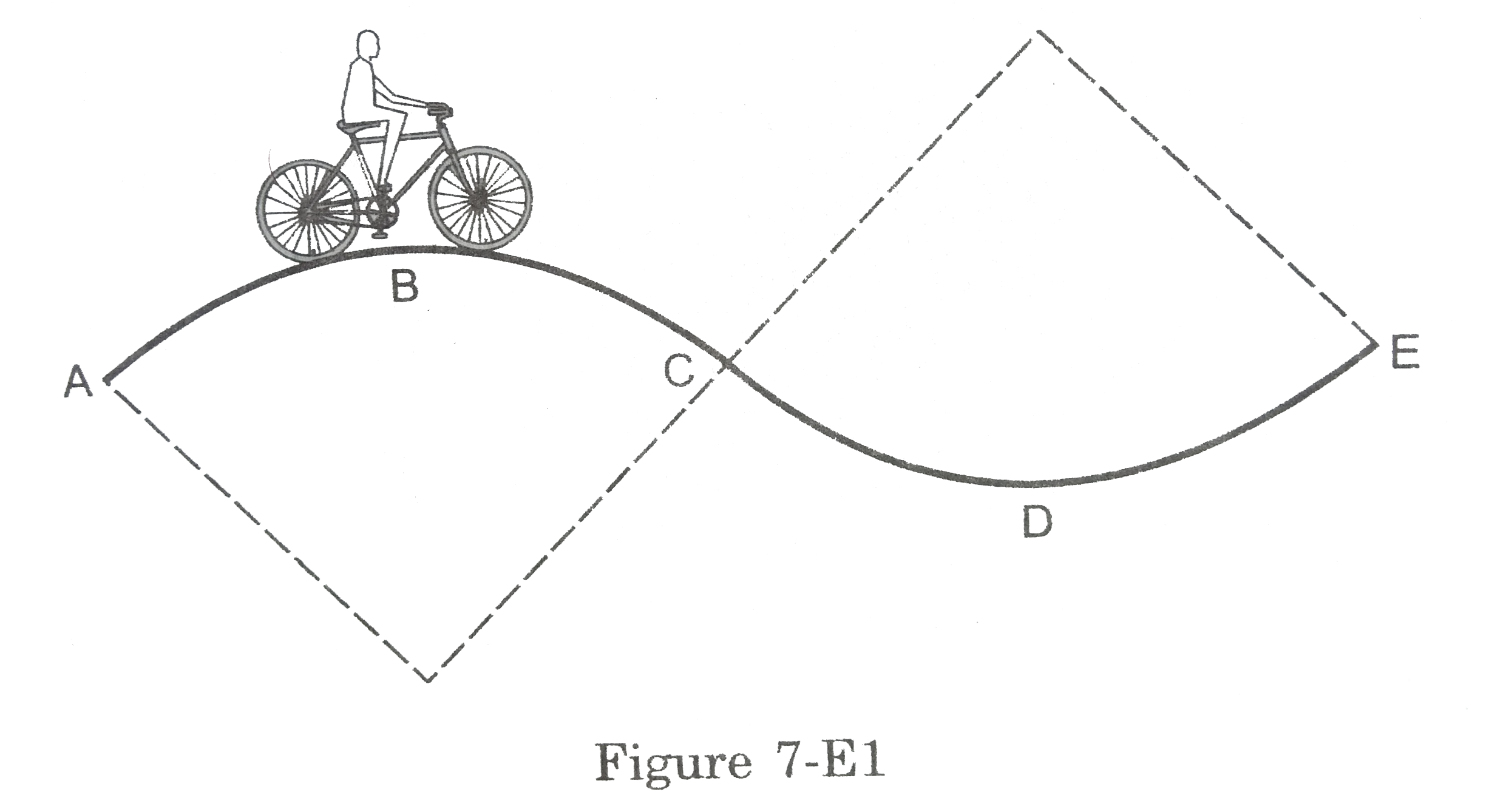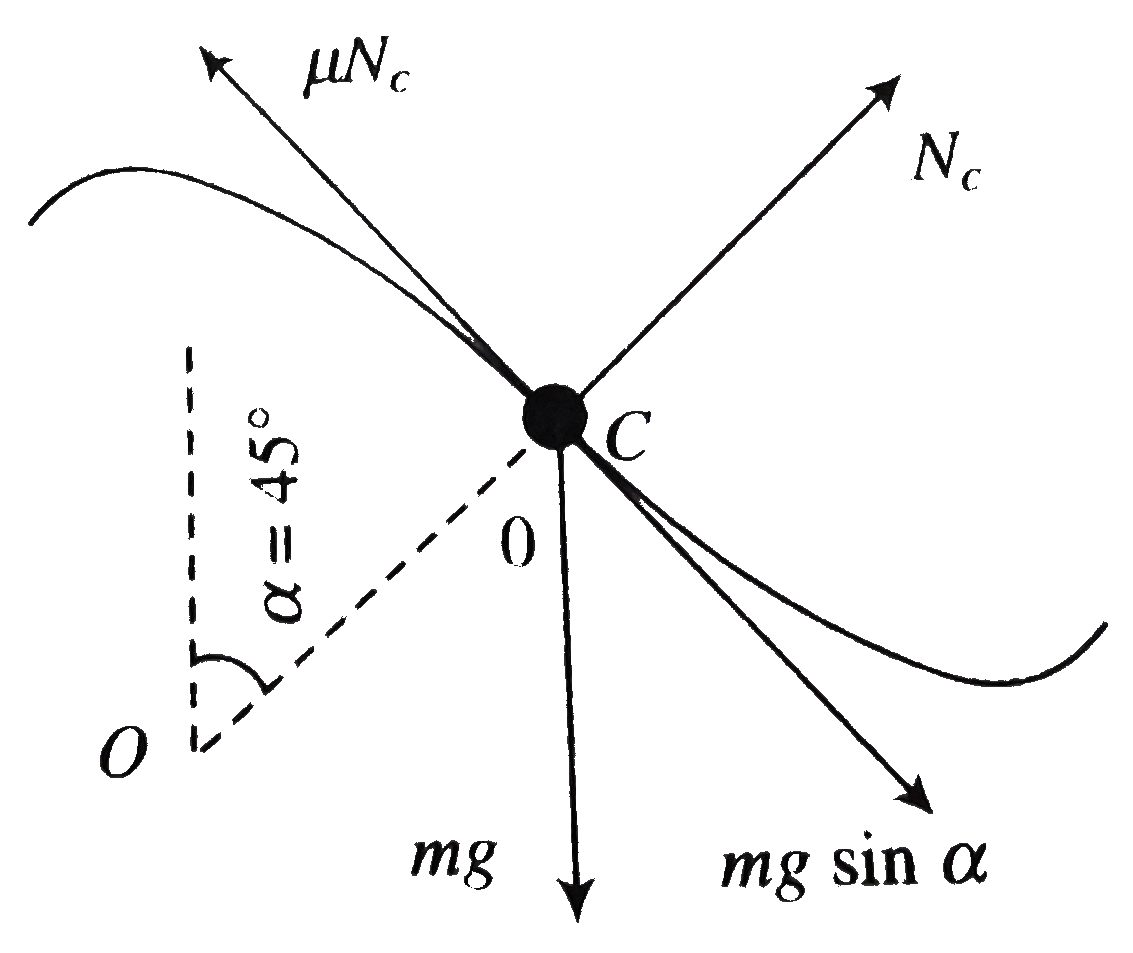A track consists of two circular pars ABC andCDE of equal rdius 100 m and joined smoothly as shown in figure.Each part sutends a right ngle at its centre. A cycle weighing 100 kg together with rider travels at a constant speed of 18 km/h on the track. A. Findteh nromal contct force by tehroad on the cycle whenit is at B and at D. b.Findteh force of friction exerted by the track on the tyres when the cycle is at B,C and D. c. Find the normal force between teh road and teh cycle just before and just after the cycle crosses C. d. What should be the minimum friction coefficient between the road and the tyre, which will ensure that teh cyclist can move with constant speed? Take g=10ms2

v=18kmh−2=180060×60=5ms−1
a. At point B verious forces acting on the cyclist are
i Weight , mg vertically downwards
ii Normal force , NB by the road upward
Since under the action of these two forces the cyclist moves in a circular path of radius r from the dynarrics of circular motion .
mv2r=mg−NB
⇒NB=m(g−v2r)=100(10−52100)=975N
At point D various force acting on the cyclist are
i. Weight , mg vertically downwards
ii Normal force , ND by the road upward
ND−mg=mv2r
⇒ND=mg(g+v2r)=100(10+52100)=1025N
b. At point B and D. the tracks are almost horizontal therefore , there is no component of g along the track at those point that will changs the speed of the cyclist since the cyclist moves with a constant speed , the friction force the at these two points is neccessarily zero.
At point C however of mg along the track that tends to accelerate the motion of the cyclist =mgsinappha
But since his speed remainn constant , a force equal and opposite to mgsinα must be acting on it and this force is the force of friction μNc where μ is the friction coefficient between the road and the type and Nc is the normal reaction at point C

Hence friction force at C is
μNc=mgsinα=100×10×sin45∘=707.12N
c. Just before the cyclist crosses point C varius force acting on him are
i. His weight, mg, vertically downwards, and
ii. Normal force Nb of the track
Hence ,from the dynamics of circular motion,we have
mgcosα−Nb=mv2r
Nb=m(gcosα−v2r)=682.11N
Just after the cyclist crosses the point C varius forces acting on him are
i. Weight, mg, vertically downwards, and
ii. Normal force Nd of the track
Hence ,from the dynamics of circular motion ,
Ndmgcosα=mv2r
⇒Nd=m(gcosα+v2r)=7.32.11N
d. The tendecy of the cyclist to skid is maximum just before the point C , the point is so because the carve is steepest at this point , Force along the track at this point =mgsinα
And friction force =μNb where Na is the normal force of of the track just before the point C
The cyclist can move with constant speed if the two forces are equal and opposite
μNb=mgsinα⇒μ=1.037
Topper's Solved these Questions
- NEWTON'S LAWS OF MOTION 2BOOK - CENGAGE PHYSICSCHAPTER - NEWTON'S LAWS OF MOTION 2EXERCISE - Exercise 7.1
25 Videos
- NEWTON'S LAWS OF MOTION 2BOOK - CENGAGE PHYSICSCHAPTER - NEWTON'S LAWS OF MOTION 2EXERCISE - Exercise 7.2
16 Videos
- NEWTON'S LAWS OF MOTION 2BOOK - CENGAGE PHYSICSCHAPTER - NEWTON'S LAWS OF MOTION 2EXERCISE - Integer type
1 Video
- NEWTON'S LAWS OF MOTION 1BOOK - CENGAGE PHYSICSCHAPTER - NEWTON'S LAWS OF MOTION 1EXERCISE - Integer
5 Videos
- PROPERTIES OF SOLIDS AND FLUIDSBOOK - CENGAGE PHYSICSCHAPTER - PROPERTIES OF SOLIDS AND FLUIDSEXERCISE - INTEGER_TYPE
2 Videos
Similar Questions
A track consists of two circular pars ABC andCDE of equal rdius 100 m and joined smoothly as shown in figure.Each part sutends a right ngle at its centre. A cycle weighing 100 kg together with rider travels at a constant speed of 18 km/h on the track. A. Findteh nromal contct force by tehroad on the cycle whenit is at B and at D. b.Findteh force of friction exerted by the track on the tyres when the cycle is at B,C and D. c. Find the normal force between teh road and teh cycle just before and just after the cycle crosses C. d. What should be the minimum friction coefficient between the road and the tyre, which will ensure that teh cyclist can move with constant speed? Take g=10ms2

View SolutionA track consists of two circular parts ABC and CDE of equal radius R and joined smoothly as shown. Each part subtends an angle 2θ at center. A vehicle of mass m travels with constant force by the road on the vehicle when it is at (i) B (ii) D (iii) just before C and (iv) just after C. (b) find the friction by the track on the vehicle when it is at B, C and D. (c) what should be the minimum friction coefficient between the road and the vehicle, which will ensure that cyclist can move with constant speed.

View Solution
Knowledge Check
If a stone of mass 0.05 kg is thrown out a window of a train moving at a constant speed of 100 km/ h then magnitude of the net force acting on the stone is
A0.5 NBzeroC50 ND5 NA 100kg car is moving with a maximum velocity of 9m/s across a circular track of radius 30 m . The maximum force of friction between the road and the car is
A1000NB706NC270ND200NTwo trains are moving at speeds 80 km/h and 100 km/h on parallel tracks in the same direction. From this information, one can say that
Athe separation between the trains must be increasingBthe separation between the trains must be decreasingCthe separation between the trains remains the sameDthe separation between the trains must be changing
A cyclist moving on a circular track of radius 100 m completes one revolution in 4 minutes What is his average speed ?
View SolutionA scooter weighing 150 kg together with its rider moving at 36 km/hr is to take a turn of radius 30 m. What horizontal force on the scooter is needed to make the turn possible?If the horizontal force needed for the turn in the previous problem is to be supplied by the normal force by the road what should be the proper angle of banking?
View SolutionA vehicle is moving on a track with constant speed as shown in figure. The apparent weight of the vehicle is

View SolutionAt what should a highway be banked for cars travelling at a speed of 100 km/h if the radius of the road is 400 m and no frictional forces are involved?
View SolutionA car runs at a constant speed on a circulat track of radius 100m. Taking 62.8s for every circular lap. The average velocity and average speed for each circular lap respectively are :
View Solution
